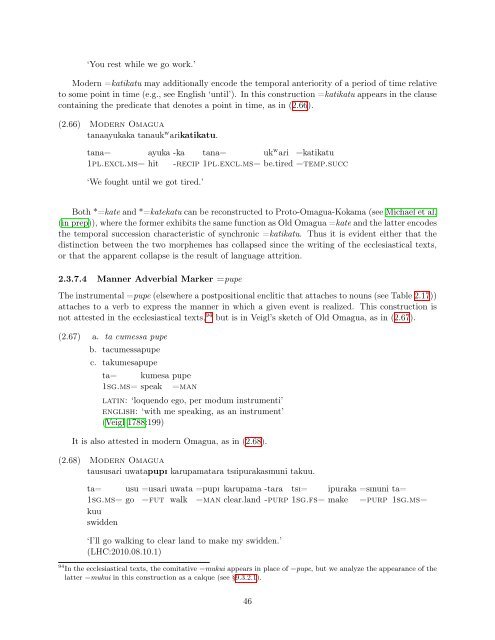draft manuscript - Linguistics - University of California, Berkeley
draft manuscript - Linguistics - University of California, Berkeley
draft manuscript - Linguistics - University of California, Berkeley
You also want an ePaper? Increase the reach of your titles
YUMPU automatically turns print PDFs into web optimized ePapers that Google loves.
‘You rest while we go work.’<br />
Modern =katikatu may additionally encode the temporal anteriority <strong>of</strong> a period <strong>of</strong> time relative<br />
to some point in time (e.g., see English ‘until’). In this construction =katikatu appears in the clause<br />
containing the predicate that denotes a point in time, as in (2.66).<br />
(2.66) Modern Omagua<br />
tanaayukaka tanauk w aRikatikatu.<br />
tana= ayuka -ka tana= uk w aRi =katikatu<br />
1pl.excl.ms= hit -recip 1pl.excl.ms= be.tired =temp.succ<br />
‘We fought until we got tired.’<br />
Both *=kate and *=katekatu can be reconstructed to Proto-Omagua-Kokama (see Michael et al.<br />
(in prep)), where the former exhibits the same function as Old Omagua =kate and the latter encodes<br />
the temporal succession characteristic <strong>of</strong> synchronic =katikatu. Thus it is evident either that the<br />
distinction between the two morphemes has collapsed since the writing <strong>of</strong> the ecclesiastical texts,<br />
or that the apparent collapse is the result <strong>of</strong> language attrition.<br />
2.3.7.4 Manner Adverbial Marker =pupe<br />
The instrumental =pupe (elsewhere a postpositional enclitic that attaches to nouns (see Table 2.17))<br />
attaches to a verb to express the manner in which a given event is realized. This construction is<br />
not attested in the ecclesiastical texts, 94 but is in Veigl’s sketch <strong>of</strong> Old Omagua, as in (2.67).<br />
(2.67) a. ta cumessa pupe<br />
b. tacumessapupe<br />
c. takumesapupe<br />
ta= kumesa pupe<br />
1sg.ms= speak =man<br />
latin: ‘loquendo ego, per modum instrumenti’<br />
english: ‘with me speaking, as an instrument’<br />
(Veigl 1788:199)<br />
It is also attested in modern Omagua, as in (2.68).<br />
(2.68) Modern Omagua<br />
taususaRi uwatapupI kaRupamataRa tsIipuRakasInuni takuu.<br />
ta=<br />
1sg.ms=<br />
kuu<br />
swidden<br />
usu<br />
go<br />
=usaRi<br />
=fut<br />
uwata<br />
walk<br />
‘I’ll go walking to clear land to make my swidden.’<br />
(LHC:2010.08.10.1)<br />
=pupI kaRupama -taRa tsI= ipuRaka =sInuni ta=<br />
=man clear.land -purp 1sg.fs= make =purp 1sg.ms=<br />
94 In the ecclesiastical texts, the comitative =mukui appears in place <strong>of</strong> =pupe, but we analyze the appearance <strong>of</strong> the<br />
latter =mukui in this construction as a calque (see §9.3.2.1).<br />
46
















